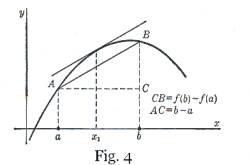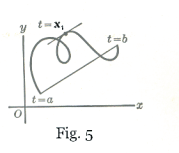
Website owner: James Miller
MEAN VALUE THEOREMS FOR DERIVATIVES; ROLLE’S THEOREM, MEAN VALUE THEOREM, CAUCHY’S GENERALIZED MEAN VALUE THEOREM, EXTENDED LAW OF THE MEAN (TAYLOR’S THEOREM)
In the following we present several mean value theorems for derivatives. The functions referred to are general functions (not just functions defined by expressions or formulas).

Rolle’s Theorem. Let f(x) be a function which is
continuous over the interval a
![]() x
x
![]() b and has a derivative at
every interior point of the interval. Then if f(a) = f(b) = 0, there
must be at least one point x1 between a and b for which f '(x1) =
0.
b and has a derivative at
every interior point of the interval. Then if f(a) = f(b) = 0, there
must be at least one point x1 between a and b for which f '(x1) =
0.
Geometrically, the theorem means that if a continuous curve intersects the x-axis at x = a and x = b, and has a tangent at every point between a and b, then there is at least one point x = x1, between a and b where the tangent is parallel to the x-axis. See Fig. 1.

If f(x) does not have a derivative at every point of the interval, the theorem doesn’t apply and there may not be any point between a and b for which f '(x) = 0. See Fig. 2.
Corollary. If f(x) satisfies the conditions of Rolle’s Theorem, except that f(a) = f(b) ≠ 0 , then f '(x) = 0 for at least one value of x, say x = x0, between a and b. See Fig. 3.

Mean value theorem. Let f(x) be a function
which is continuous over the interval a
![]() x
x
![]() b and has a
derivative at every interior point of the interval. Then
there must be at least one point x1 between a and b such
that
b and has a
derivative at every interior point of the interval. Then
there must be at least one point x1 between a and b such
that
![]()
Syn. Law of the Mean
The theorem is geometrically obvious. See Fig. 4. The slope of the chord AB is

![]()
The theorem simply states that under the conditions specified there must be a point on the curve between A and B where the slope of the curve is equal to the slope of AB.
Proof of the Mean value Theorem. In proving this theorem we perform a stunt of magic. We pull a strange, nonsensical looking function out of a magic hat and present it to the reader. Noting that it meets the conditions required by Rolle’s Theorem, we apply Rolle’s Theorem to it and voila! The reader is staring at the required proof!
The function that we pull out of a hat and present to the reader is
![]()
We note that it meets the requirements of Rolle’s Theorem: F(a) = 0 , F(b) = 0 and if f(x) satisfies the conditions on continuity and differentiability specified in Rolle’s Theorem, then F(x) satisfies them also. Rolle’s Theorem requires the expression for F '(x). Taking the derivative of F(x)
![]()
Rolle’s Theorem states that for some value x = x1 between a and b
![]()
Thus
![]()
and the theorem is proved.
Cauchy’s Generalized Mean Value Theorem. Let f(x) and g(x) be two functions which are continuous on the closed interval [a, b] and differentiable on the open interval (a, b). Assume further that g(a) ≠ g(b) and that f '(x) and g'(x) are never simultaneously zero at any point on the open interval (a, b). Then there exists a point x1 in (a, b) such that
![]()
Syn. Generalized Law of the Mean, Double Law of the Mean, Cauchy’s Mean Value Formula
A geometrical interpretation may be given for the theorem as follows: Let a plane curve be represented parametrically by the equations
x = g(t)
y = f(t)
where a
![]() t
t
![]() b. See Fig. 5. The slope of the curve for a
given t is
b. See Fig. 5. The slope of the curve for a
given t is

![]()
The constant
![]()
is the slope of the straight line joining the points on the curve corresponding to t = a and t = b, respectively. The theorem says that the two slopes 1) and 2) are equal for at least one value of t between a and b.
Proof of Cauchy’s Generalized Mean Value Theorem. In proving this theorem we again perform a stunt of magic. We pull a strange, nonsensical looking function out of thin air and present it to the reader. Noting that it meets the conditions required by Rolle’s Theorem, we apply Rolle’s Theorem to it and voila! The reader is staring at the required proof!
The function that we pull out of a hat and present to the reader is
![]()
We note that it meets the requirements of Rolle’s Theorem: F(a) = 0 , F(b) = 0 and if f(x) and g(x) satisfy the conditions on continuity and differentiability specified in Rolle’s Theorem, then F(x) satisfies them also. Rolle’s Theorem requires the expression for F '(x). Taking the derivative of F(x)

Rolle’s Theorem states that for some value x = x1 between a and b
![]()
Rearranging we obtain
![]()
and the theorem is proved.
Extended law of the mean. Let a function f(x) and its first n derivatives be continuous on the closed interval [a, b] and let the (n+1)st derivative f (n + 1)(x) exist on the open interval (a, b). Then there is a number x0 between a and b such that
![]()
in which Rn+1(x), the remainder after n + 1 terms, is given by the formula

When b is replaced by the variable x, 4) becomes

in which Rn+1(x), the remainder after n + 1 terms, is given by the formula

Formula 5) can be recognized as Taylor’s Formula. The Extended Law of the Mean is a variation of Taylor’s Formula.
Proof of the Extended Law of the Mean. We now present the proof of 4) above. In proving this theorem we again perform our stunt of magic. This time we pull two strange looking functions out of thin air and present them to the reader. Noting that the two functions meet the conditions required by Cauchy’s Generalized Mean Value Theorem, we apply the theorem and, in a step or two, have the proof.
The functions that we pull out of a hat and present to the reader are
![]()
![]()
We observe that these two functions meet the requirements of Cauchy’s Generalized Mean Value Theorem. We also observe that F(b) = G(b) = 0. To use Cauchy’s theorem we need the expressions for F'(x) and G'(x). When we differentiate F(x) we discover that a great deal of cancellation occurs between terms. The derivative of F(x) is found to be

The derivative of G(x) is
![]()
We now apply Cauchy’s Mean Value Theorem. Since F(b) and G(b) are zero, it reads
![]()
or
![]()
where x0 is some number between a and b. Substituting 7), 8) and 9) into 11) we get
![]()
If we now put x = a in 6) and use 12) we obtain the desired formula 4) above.
Jesus Christ and His Teachings
Way of enlightenment, wisdom, and understanding
America, a corrupt, depraved, shameless country
On integrity and the lack of it
The test of a person's Christianity is what he is
Ninety five percent of the problems that most people have come from personal foolishness
Liberalism, socialism and the modern welfare state
The desire to harm, a motivation for conduct
On Self-sufficient Country Living, Homesteading
Topically Arranged Proverbs, Precepts, Quotations. Common Sayings. Poor Richard's Almanac.
Theory on the Formation of Character
People are like radio tuners --- they pick out and listen to one wavelength and ignore the rest
Cause of Character Traits --- According to Aristotle
We are what we eat --- living under the discipline of a diet
Avoiding problems and trouble in life
Role of habit in formation of character
Personal attributes of the true Christian
What determines a person's character?
Love of God and love of virtue are closely united
Intellectual disparities among people and the power in good habits
Tools of Satan. Tactics and Tricks used by the Devil.
The Natural Way -- The Unnatural Way
Wisdom, Reason and Virtue are closely related
Knowledge is one thing, wisdom is another
My views on Christianity in America
The most important thing in life is understanding
We are all examples --- for good or for bad
Television --- spiritual poison
The Prime Mover that decides "What We Are"
Where do our outlooks, attitudes and values come from?
Sin is serious business. The punishment for it is real. Hell is real.
Self-imposed discipline and regimentation
Achieving happiness in life --- a matter of the right strategies
Self-control, self-restraint, self-discipline basic to so much in life